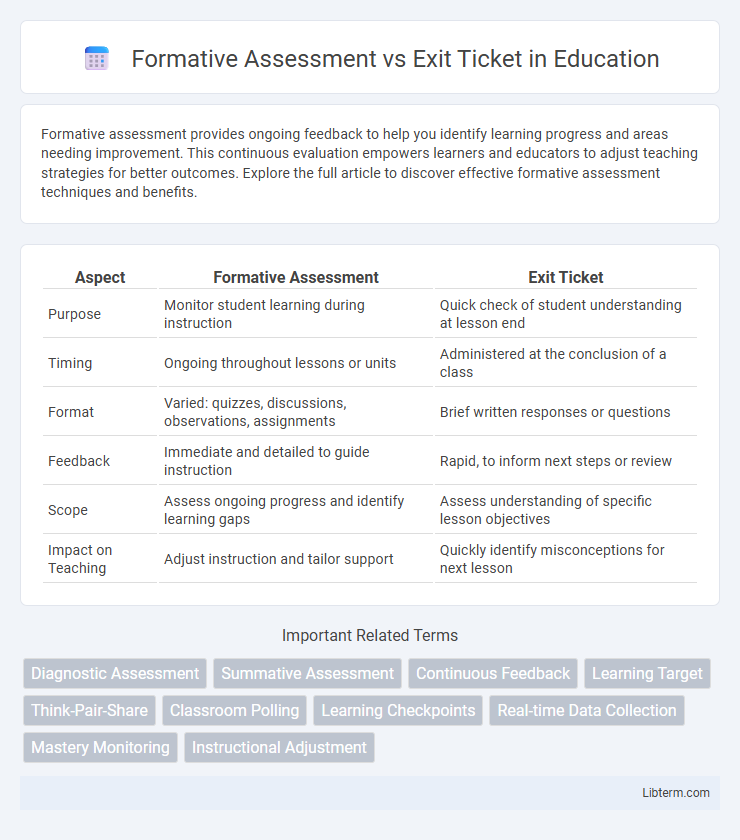Formative assessment provides ongoing feedback to help you identify learning progress and areas needing improvement. This continuous evaluation empowers learners and educators to adjust teaching strategies for better outcomes. Explore the full article to discover effective formative assessment techniques and benefits.
Table of Comparison
| Aspect | Formative Assessment | Exit Ticket |
|---|---|---|
| Purpose | Monitor student learning during instruction | Quick check of student understanding at lesson end |
| Timing | Ongoing throughout lessons or units | Administered at the conclusion of a class |
| Format | Varied: quizzes, discussions, observations, assignments | Brief written responses or questions |
| Feedback | Immediate and detailed to guide instruction | Rapid, to inform next steps or review |
| Scope | Assess ongoing progress and identify learning gaps | Assess understanding of specific lesson objectives |
| Impact on Teaching | Adjust instruction and tailor support | Quickly identify misconceptions for next lesson |
Understanding Formative Assessment
Formative assessment is a continuous process that gathers detailed information about student learning to inform instruction and improve understanding. Unlike exit tickets, which are brief summaries completed at the end of a lesson, formative assessments encompass diverse strategies like quizzes, observations, and discussions that provide ongoing feedback. This approach helps educators identify learning gaps and adjust teaching methods to support student progress effectively.
What is an Exit Ticket?
An exit ticket is a brief, formative assessment tool used at the end of a lesson to quickly gauge students' understanding of the key concepts covered. It typically consists of a few targeted questions or prompts that help teachers identify areas of confusion and adjust future instruction accordingly. Exit tickets provide immediate feedback on student learning and promote reflection without disrupting class flow.
Purpose and Goals: Formative Assessment vs Exit Ticket
Formative assessments aim to monitor student learning progress throughout an instructional period, providing ongoing feedback to inform teaching strategies and enhance student understanding. Exit tickets are brief, targeted tools used at the end of a lesson to quickly gauge student comprehension of specific concepts or skills covered that day. While formative assessments serve broader instructional adjustments, exit tickets focus on immediate insight to guide the next lesson's planning.
Key Differences Between Formative Assessment and Exit Ticket
Formative assessment encompasses a broad range of strategies, such as quizzes, observations, and discussions, designed to monitor student learning and provide ongoing feedback throughout a lesson or unit. Exit tickets are a specific, quick formative assessment tool completed at the end of a lesson to gauge students' understanding of key concepts before moving forward. The key difference lies in scope and timing: formative assessments are continuous and varied, while exit tickets are concise, targeted checks conducted immediately after instruction.
Methods and Examples of Formative Assessment
Formative assessment methods include quizzes, peer reviews, classroom discussions, and observational checklists that provide ongoing feedback to both students and teachers. Examples of effective formative assessments are think-pair-share activities, concept maps, and quick writes that help monitor student understanding during instruction. These approaches foster active learning and allow for timely adjustments to teaching strategies.
How to Effectively Use Exit Tickets
Exit tickets serve as a concise formative assessment tool that captures students' understanding at the end of a lesson, providing immediate feedback for instructional adjustment. To effectively use exit tickets, teachers should design clear, focused questions targeting key learning objectives and review responses promptly to identify misconceptions and gaps. Integrating exit ticket data into lesson planning ensures timely intervention, fostering a responsive and data-driven classroom environment.
Benefits of Formative Assessment in the Classroom
Formative assessment provides continuous insights into student learning, enabling teachers to adjust instruction in real-time and address individual needs effectively. It promotes active engagement, critical thinking, and self-reflection, leading to improved understanding and retention of material. Unlike exit tickets, formative assessments offer a broader scope for feedback and allow ongoing monitoring of progress throughout a lesson or unit.
Advantages of Using Exit Tickets for Student Feedback
Exit tickets provide immediate, focused feedback on student understanding, enabling teachers to quickly identify learning gaps and adjust instruction accordingly. They encourage student reflection and active participation, fostering greater engagement and self-awareness in the learning process. Compared to broader formative assessments, exit tickets are time-efficient and flexible, making them ideal for continuous, real-time monitoring of classroom progress.
Best Practices: Integrating Both Tools in Teaching
Formative assessment and exit tickets serve complementary roles in monitoring student learning, with formative assessments providing ongoing, in-depth feedback while exit tickets offer quick, targeted insights at the end of a lesson. Best practices in integrating these tools include using formative assessments to identify learning gaps throughout instruction and employing exit tickets to gauge immediate understanding and inform next steps. Combining both strategies enhances instructional responsiveness, fosters student reflection, and supports data-driven decision-making for differentiated teaching.
Choosing the Right Approach: When to Use Formative Assessments or Exit Tickets
Formative assessments provide ongoing insights into student understanding throughout a lesson, ideal for adjusting instruction in real time and identifying learning gaps. Exit tickets are best used at the end of a class to quickly gauge student comprehension and inform the planning of subsequent lessons. Selecting between formative assessments and exit tickets depends on whether continuous monitoring during instruction or a final check of learning outcomes is the primary goal.
Formative Assessment Infographic

 libterm.com
libterm.com